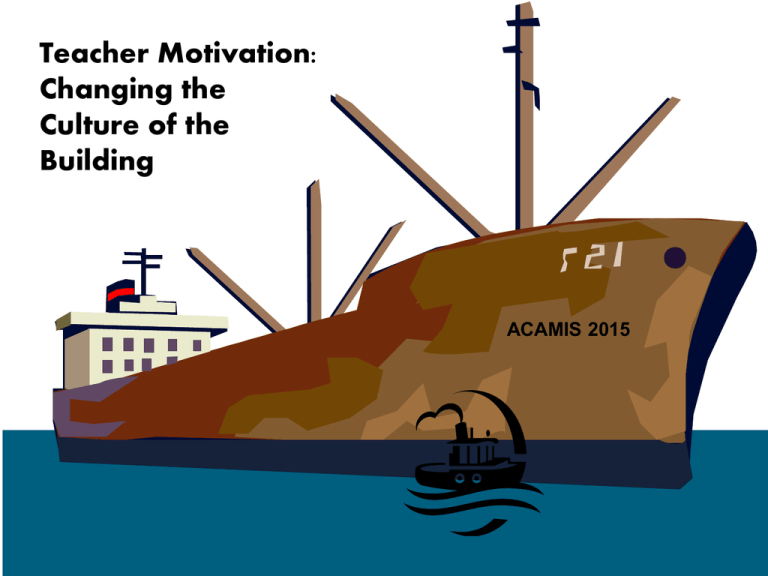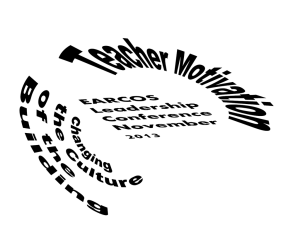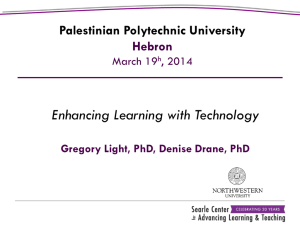ACAMIS 2015 Teacher Motivation Changing Culture of Building
advertisement

Teacher Motivation: Changing the Culture of the Building ACAMIS 2015 For further conversation about any of these topics: Rick Wormeli rwormeli@cox.net 703-620-2447 Herndon, Virginia, USA (Eastern Standard Time Zone) @Rickwormeli2 (Twitter) Great book to get started: The Differentiated School: Making Revolutionary Changes in Teaching and Learning Carol Ann Tomlinson, Kay Brimijoin, Lane Narvaez ASCD 2008 Also, to Get Started: Transforming School Culture: How to Overcome Staff Division Anthony Muhammad, Solution Tree Press, 2009 Talk About Teaching! Leading Professional Conversations, NASSP/Corwin/NSDC, 2009 Leading Change in your School: How to Conquer Myths, Build Commitment, and Get Results, ASCD, 2009 Breaking Ranks: A Field Guide to Leading Change, NASSP, 2009 (Don’t forget BRIM – Breaking Ranks in the Middle, too!) A Process Circle for Guiding Change [From Breaking Ranks, NASSP, 2011] Accept the fact that there is no one way to get your whole faculty on board. Waiting for 100% buy-in is a willful act of failure. Another Act of Willful Failure: Changing structures, programs without changing teacher beliefs as well. Three Premises: •We can control and coerce someone to do something, but we can’t motivate anyone to do anything they don’t already want to do. •Motivation is only doing to the best of our ability what we are already capable of doing. (Rick Lavoie, F.A.T. City Workshop: How Difficult Can This Be?” PBS Video) •Motivation is not something we do to teachers, it is something we create with them. If those are true, then: Our focus is to create an environment that cultivates curiosity and personal investment, making sure students and teachers feel safe to engage in the activity or topic without fear of embarrassment or rejection. And, we accept the fact that there is no such thing as laziness. As leaders, we all have our own philosophy/pedagogy that we believe. To what degree will we allow our teachers to hold beliefs and conduct practices different from our own? “Most of the time I’m a leader, but sometimes I have to be the boss.” -- quote from a highly accomplished middle level principal Focus on principles, then gather your solutions: Quite often, effective teaching is 90% mindset, 10% craft and mechanics. With colleagues, reflect on the bigger questions: How does my approach reflect what we know about studetns this age? Why do we grade students? Does our current approaches best serve students? How do we communicate with parents? How does assessment inform our practice? Is what we’re doing fair and developmentally appropriate? How can we counter the negative impact of poverty/mobility on our students’ learning? What role does practice play in mastery? What is mastery for each curriculum we teach? What is homework, and how much should it count in the overall grade? How are our current structures limiting us? With colleagues, reflect on the bigger questions: Whose voice is not heard in our deliberations? What do we know about differentiated practices and the latest in cognitive theory and how are those aspects manifest in our classrooms? If not, why not? Are we mired in complacency? Are we doing things just to perpetuate what has always been done? Are we open to others’ points of view – why or why not? Does our report card express what we’re doing in the classroom? How are modern classrooms different from classrooms thirty years ago? Where will our practices look like 15 years from now? To what extent do we allow state, provincial, country, or international exams to influence our classroom practices? Just because we can’t fathom the logistics doesn’t mean we abandon the principle. Writer and educator, Margaret Wheatley, is correct: “We can’t be creative unless we’re willing to be confused.” Cultivate Teacher Creativity. Seriously, it’s just as vital as content expertise, professional behavior, and maintaining proper records. Do we have the creativity to solve our own problems? •My whole lesson today is based on accessing those three Websites, but the school’s Internet is down, so what can we do instead? •Small groups are not working in my class, yet I know they’re important for many students’ learning. How do I get these students to stay focused on their group tasks? •I’ve backed myself into a corner explaining an advanced science concept, and it’s not making sense to me, let alone to my students. What should I do? •Angelica is far beyond where I’m comfortable teaching, but we have two more weeks in this unit for the rest of the class. What will I do with her that honors her readiness level? • I’m supposed to differentiate for some of my students, but I don’t see any time to do it. • My school’s current electronic gradebook system doesn’t allow me to post anything but normreferenced scores, and I want to be more criterionreferenced in my grades. What can I do? • Because I’m a veteran teacher, I’ve been asked to be the rotating teacher using a cart and moving from classroom to classroom each period so the new teacher can have his own room and not have so much to deal with his first year. How will I handle this? Don’t succumb to the opinions of untrained parents, business leaders, and politicians. “Trust your training, you will.” Use informed opinion, not unexamined rituals. or blind adherence to district declarations. Reform happens easiest and works best in schools in which teachers participate in national/international conversations. Build these connections with faculty. Don’t succumb to intellectual bias. Build Empathy. In Case You’re Interested: Articles with More Ideas • • • • “Patient and Tenacious Teaching” “The Intellectual Life of Teachers” “Empathy as Doorway to Effectiveness” “Writing Education Articles” Give teachers feedback in the manner in which we want them to give feedback to students. Experiencing the positive of such, they are inclined to offer it to students. Ask teachers to tell the story of how they learned their craft. Ask teachers to submit to the same evaluation requirements as they demand of their students. Two Ways to Begin Using Descriptive Feedback: • “Point and Describe” (from Teaching with Love & Logic, Jim Fay, David Funk) • “Goal, Status, and Plan for the Goal” 1. Identify the objective/goal/standard/outcome 2. Identify where the student is in relation to the goal (Status) 3. Identify what needs to happen in order to close the gap Effective Protocol for Data Analysis and Descriptive Feeddback found in many Schools: Here’s What, So What, Now What 1. Here’s What: (data, factual statements, no commentary) 2. So What: (Interpretation of data, what patterns/insights do we perceive, what does the data say to us?) 3. Now What: (Plan of action, including new questions, next steps) Premise: A teacher waiting for the school or district to provide professional development for him isn’t even treading water. We are responsible for our own professional development. Our Own Professional Development • Mentoring • Professional Reading • Reflective Learning Logs • Listservs, on-line communities • Instructional Roundtables • Professional Learning Communities • Faculty Portfolios • Videotaping and Analysis • Workshops and Conferences • Web casts and Videoconferencing • Action research • National Board Certification Great On-line Tutorials about Teaching and/or the Subjects We Teach • • • • • • www.teachingchannel.org www.schooltube.com www.teachertube.com www.khanacademy.org www.youtube.com Authors/Publishers often have videos (www.stenhouse.com/fiae) Teacher Inservice Training • • • • • • • • • • • GETCA speakers www.ascd.org www.sde.com www.leadandlearn.org www.nassp.org Specific subject professional organizations Authors and presenters www.aeispeakers.com Speaker’s bureaus “Wisdom Within” – experts in the building already Consider Webcasts, E-Seminars, or Videocasts Subscribe Sample Smartbrief Topics: •RSS Feeds •Blogs •Magazines/journals •Updates •Smartbrief • • • • • • • • • • • • • Stem Education Middle Level Teaching Special Education ASCD Global News Ed Tech Geography English and Literacy Social Studies Math Scientific Research Education Leadership Education Policy Good Idea: Maintain a place on the school’s Intranet to post notes from conferences, article summaries, relevant blogs, etc. as well as questions. Have those questions answered by teachers or guest experts (local and national trainers and authors on differentiation). Don’t forget On-line, Live Professional Development just for you or faculty: • Google Hangout • Skype • Live Webinars Twitter! At www.twitter.com, type in your name, e-mail, and a password. You can enhance things a bit by editing your on-line profile, too, which includes a place to upload a picture of yourself (or not), a school or sports logo (or not), and a place to post a short descriptor of you that will display any time someone wants to find out more about you or help friends make sure you are the correct, “Amy Smith,” from a list of seven of them. #sbgchat -- Don’t forget Twitter Chats and Storify! While on Twitter, we can see photos, videos, and thoughts of others real-time as they happen. In a given minute on Twitter, educators post the links to live streaming video of Venus passing across the Sun, a famous author’s keynote address, an orchestra’s riveting performance of Edvard Grieg’s work, a tour guide’s explanation of sculpture in Florence, Italy, a surprise discovery under ice in the Antarctic, or the final moments of World Cup football (soccer). We can “sit in” on classroom lessons delivered all over the world, and if the teachers allows, we can interact with their participants as they happen. For your own Professional Development, Write Education Articles and Blogs Writing Media to Consider: •Magazine/Journal/Newsletter Articles •GPS or IPS (see other slides on this) •Listservs •Blogs •Editorials •Journaling •Books •Twitter •“White Papers” Study Executive Function portions of the brain! Late, Lost, and Unprepared Joyce Cooper-Kohn, Laurie Dietzel Smart but Scattered Peg Dawson, Richard Guare Also, Smart but Scattered Teens! Personal Well-Being • Wash your hands • Establish friendships with custodial and front office staff • Learn CPR • Get sleep • Exercise • Drink water • Stay sharp verbally Carrots and stick approaches don’t work. Avoid them. Three elements in intrinsic motivation: • Autonomy -- the ability to choose what and how tasks are completed • Mastery -- the process of becoming adept at an activity • Purpose -- the desire to improve the world. -- Daniel H. Pink Drive: The Surprising Truth about What Motivates Us 2009 Build teacher autonomy. When teachers retain autonomy to make lesson changes they find effective, they take responsibility for the outcomes. They commit to a lesson’s success more personally, analyzing their actions and revising thoughtfully. Examples of Teachers’ Lack of Autonomy: Mandated scripted programs with no option to adjust it according to students’ needs… “Teachers are warned to plan accordingly because the paper supply will run out in January… The master schedule cannot be changed to accommodate a compelling guest speaker… Teachers can’t incorporate a new “app” in their lessons because it promotes the use of personal technology that school hasn’t sanctioned… New students are three grade levels below grade-level proficiencies but they must do well on the final exam anyway… No, you can’t take that field trip with the class because you only get one per year, and it would be too much time away from preparing for the annual exam. Create a Culture of Expectancy “This is our way of doing things around here.” Letter to potential new faculty Immersion -- If it’s in sight, it’s in mind, so put it in sight. Publicize at faculty meetings, newsletters, letter to parents, news organizations, Website Promote in public spaces used by teachers Attach differentiated instruction practices to professional goals and annual evaluation What if there were no hypothetical questions? 1. Students are working in small groups on an assigned task. One student isn’t cooperating with the rest of his group, however, and as a result, the group is falling farther behind the other groups. What happens when it comes to grading the group’s product? 2. A student keeps re-doing an essay in order to improve his grade, but he seems to disregard the advice the teacher gives him on each attempt. He makes a few cosmetic changes and re-arranges some words, but there’s no substantive change. He and the teacher are getting frustrated at his lack of progress. 3. Eleven students do not do the assignment from last night. Consequently, they are not prepared to move on with the class in today’s task. What is an effective instructional response? And when it comes to assessment? 4. A student just moved into your class and school from out of state, and he seems to not have the basic foundations that you’ve already taught your class. Those foundations are very important for students to know for the next unit of study you have to teach. Everyone needs to save face and be honored. Some teachers and school leaders are irrational, territorial, uninformed, or ill-suited to their jobs. With these people we can: •Help them see how they come across in whatever diplomatic way we can •Help them get guidance if they are poorly trained •Offer them alternative compromises between their needs and our needs so that both are served •Educate them patiently so they can “save face,” by speaking from understanding and not being threatened by the proposed changes • Present concerns along with their solutions so they are not stressed further • Acknowledge that they are having a tough time and come across as supportive, not adversarial • Quit working for him or her • Make it very comfortable for him or her to vacate the position • Share our concerns with someone in supervisory capacity Rotate meeting places in order to fully dimensionalize colleagues—so they become more than stereotypes and caricatures. In order for someone to accept feedback or your new idea, they must first admit what he was doing could be improved, or was less effective than he thought it was. When disagreeing, is it better to say, “Tell me more about that,” or to roll our eyes in derision? Put norms in place in which it is safe to question the status quo without fear of reprisals or looking ridiculous. Invite Devil’s Advocate, Socrates, “Yes, but…” questions to let folks to get answers to specific concerns, but also facilitate an equal number of “Yes, and…” responses in which colleagues improve or extend ideas. Skill Sets Teachers Need in Order to Work Together to Improve Practices • How to write and talk about teaching; how to make the implicit explicit • Formative versus Summative Assessments • Cognitive Science applied in the classroom • How to critique each other constructively • How to work with mentors/coaches • How to read, critique, and share professional materials – text, Websites, videos, research. Ask what a respected colleague or leader would do. Realize that every administrator/teacher wants students to be successful. If you find a better way to achieve student success, don’t be bashful. Present it. Present problems with their solutions. Put time, energy, people, and money into coaching/mentoring teachers. Consider: -- -- PLC’s -- Critical Friends Network -- Teacher Action Research Teams -- Becoming a Lab School for a local University -- Beginning teacher induction programs End hypocrisy… Deviate from the program here and there as necessary for students’ success, but translate what you’re doing into the language of the district so you can keep your job. Tell those questioning your deviation from the establish program that you’re doing a “pilot.” People get panicked by permanence. Start with a Few… Identify 3 or 4 staff already differentiating or willing to give it a shot…and support their journey with everything you’ve got. Ask them to present their journey to the faculty -- ‘mistakes, successes, ‘everything. Invite a parent or three to be a part of the conversations. Regularly Affirm Small Steps • • • • • • • public recognition at faculty gatherings private notes of thanks & encouragement take over a teacher’s class in order to give her an extra planning period refer a teacher looking for help to a successful teacher post teacher successes somewhere visible invite news organizations to interview teachers who’ve been successful ask successful teachers to take on leadership roles “Dipstick” frequently. (a John Saphier term) This includes a checklist for evidence of standards-based assessment/grading in your Walk-through observations. Ask teachers to present evidence in planning and practice. Consider both quantitative and qualitative measures. What would this look like? Bring at least one parent to every conference or in-service training. Open each Faculty Meeting with the Idea A different group shares their interactions with the topic for five to ten minutes each meeting. Rotate different departments and grade levels through the presentation duty. Use Department Meetings At every department meeting: Discuss an aspect of the idea and prepare a report for the administration Ask: What does this look like in our discipline? Disseminate articles/ideas in teacher boxes Keep the idea(s) in front of teachers so it doesn’t get moved to the back burner. Make sure to follow up with a structured interactions. Publicize! Add the new program or emphasis to the school’s publications such as newsletters, Website, Work Plan, accreditation materials, and promotional school materials. Conduct Instructional Roundtables • • • One-hour or less Someone (not limited to leaders) posts a topic for discussion and a location for the meeting two weeks in advance All are invited, but ‘must have one idea to share (photocopied) as ticket to the roundtable Conduct Book Study Groups • • • Teachers and administrators Request study guides from publisher, if available One month in duration, if possible Peer Observation System • • • • Create a system of collegial feedback in which teachers observe and analyze each other’s lessons in light of the new faculty emphasis. Assign someone the task of coordinating who’s partnering with whom, as well as the dates and times for observations and post-observation analysis. Observations can be in person by giving up an occasional planning (or providing a sub for a non-planning period slot), or it can be done by video-taping the class and analyzing the lesson with a colleague later. Enlist retirees and parents to do the video-taping, if that’s easier. C.B.A.M. -Concerns-Based Adoption Model Teachers move through different stages of concern – for themselves, for the task, for the new idea’s impact – as well as through stages of use. If we respond to each level of concern and how teachers are using the idea, teachers are more willing to partake in the new initiative. Teacher Concerns 6 - Refocusing 5 – Collaboration 4 – Consequences 3 – Management 2 – Personal 1 – Informational 0 – Awareness Teachers Use of the New Idea 6 – Renewal 5 – Integration 4a/4b – Refinement/Routine 3 – Mechanical 2 – Preparation 1 – Orientation 0 – Non-use Great CBAM Resources: Taking Charge of Change Shirley M. Hord, William L. Rutherford, Leslie HulingAustin, Gene E. Hall ASCD, 1987 Also try, Southwest Educational Development Laboratory catalog: www.sedl.org/pubs/catalog/items/cbam15.html Stage 3 Stage 2 Stage 1 Keep the timeline and accomplishments evervisible. Processing Activity: “I used to think…, but now I think…” “I like, I wish, What if” (p. 121, Seelig) What goes unachieved in students because we chose to be politically safe?







